Nursing Report: Osteoporosis Case Study, Diagnosis, and Treatment
VerifiedAdded on 2020/04/07
|9
|2015
|77
Report
AI Summary
This report presents a nursing case study focused on an 80-year-old patient, Marika, diagnosed with osteoporosis. The assignment delves into the pathophysiology of osteoporosis, exploring the mechanisms behind bone weakening and fragility, considering factors like peak bone mass, genetic influences, and lifestyle choices such as calcium and vitamin D deficiencies. The report details diagnostic tests, specifically bone density tests, and discusses the symptoms Marika exhibited, including pain and functional limitations. Furthermore, it outlines various treatment options, including bisphosphates, hormone-like medications, and supplements like calcium and vitamin D, emphasizing the importance of a holistic approach to managing the condition. The report concludes by summarizing the key aspects of osteoporosis, its impact, and the range of treatment strategies available for patients like Marika.
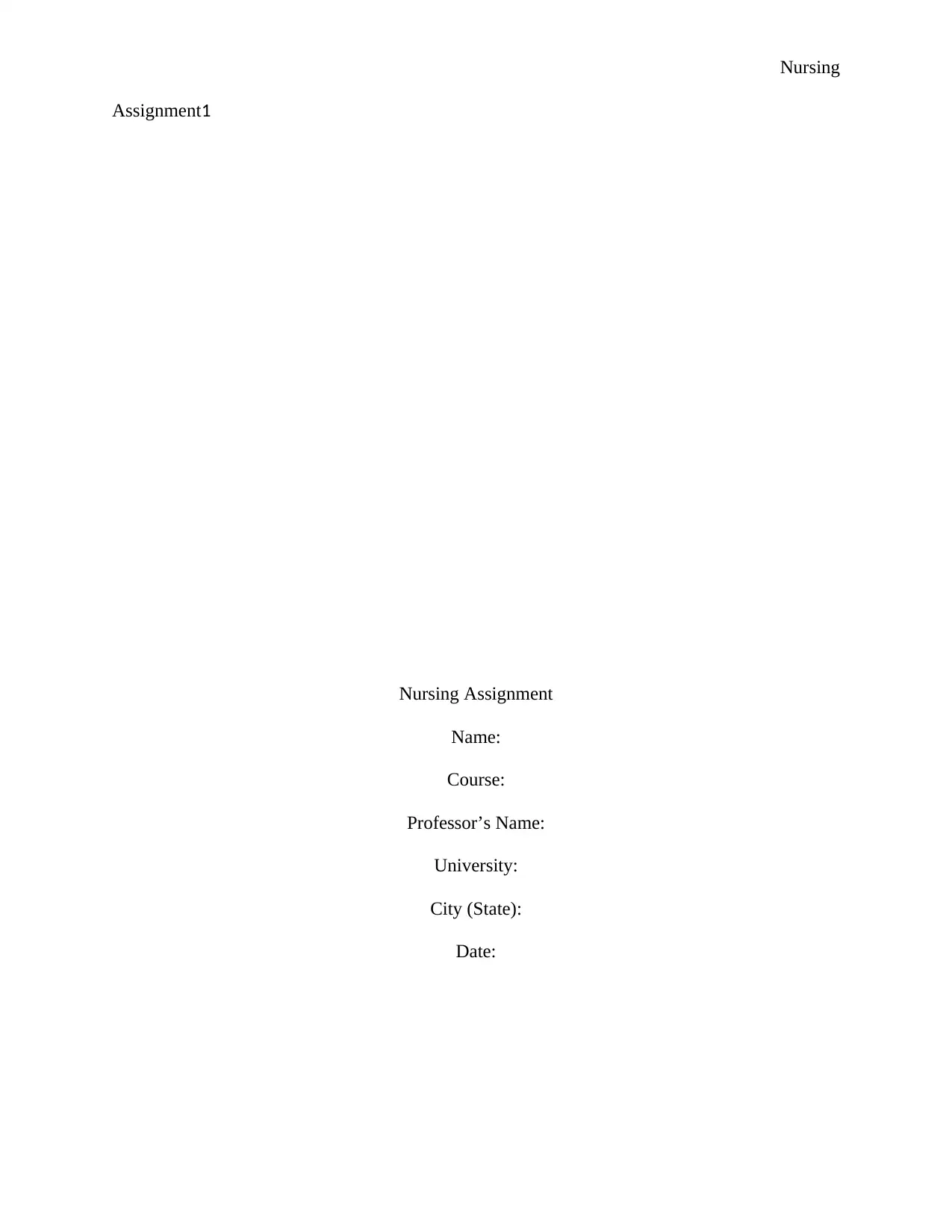
Nursing
Assignment1
Nursing Assignment
Name:
Course:
Professor’s Name:
University:
City (State):
Date:
Assignment1
Nursing Assignment
Name:
Course:
Professor’s Name:
University:
City (State):
Date:
Paraphrase This Document
Need a fresh take? Get an instant paraphrase of this document with our AI Paraphraser
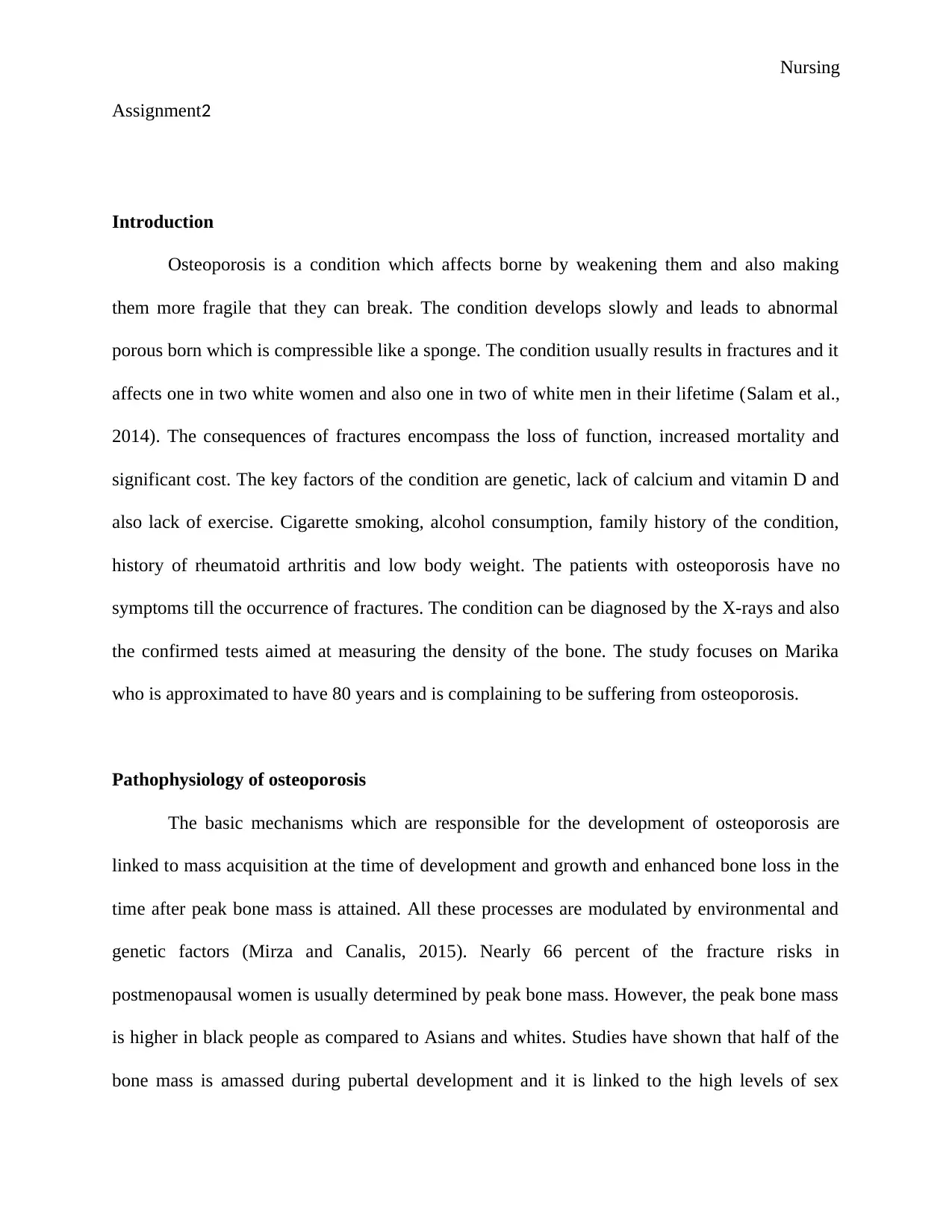
Nursing
Assignment2
Introduction
Osteoporosis is a condition which affects borne by weakening them and also making
them more fragile that they can break. The condition develops slowly and leads to abnormal
porous born which is compressible like a sponge. The condition usually results in fractures and it
affects one in two white women and also one in two of white men in their lifetime (Salam et al.,
2014). The consequences of fractures encompass the loss of function, increased mortality and
significant cost. The key factors of the condition are genetic, lack of calcium and vitamin D and
also lack of exercise. Cigarette smoking, alcohol consumption, family history of the condition,
history of rheumatoid arthritis and low body weight. The patients with osteoporosis have no
symptoms till the occurrence of fractures. The condition can be diagnosed by the X-rays and also
the confirmed tests aimed at measuring the density of the bone. The study focuses on Marika
who is approximated to have 80 years and is complaining to be suffering from osteoporosis.
Pathophysiology of osteoporosis
The basic mechanisms which are responsible for the development of osteoporosis are
linked to mass acquisition at the time of development and growth and enhanced bone loss in the
time after peak bone mass is attained. All these processes are modulated by environmental and
genetic factors (Mirza and Canalis, 2015). Nearly 66 percent of the fracture risks in
postmenopausal women is usually determined by peak bone mass. However, the peak bone mass
is higher in black people as compared to Asians and whites. Studies have shown that half of the
bone mass is amassed during pubertal development and it is linked to the high levels of sex
Assignment2
Introduction
Osteoporosis is a condition which affects borne by weakening them and also making
them more fragile that they can break. The condition develops slowly and leads to abnormal
porous born which is compressible like a sponge. The condition usually results in fractures and it
affects one in two white women and also one in two of white men in their lifetime (Salam et al.,
2014). The consequences of fractures encompass the loss of function, increased mortality and
significant cost. The key factors of the condition are genetic, lack of calcium and vitamin D and
also lack of exercise. Cigarette smoking, alcohol consumption, family history of the condition,
history of rheumatoid arthritis and low body weight. The patients with osteoporosis have no
symptoms till the occurrence of fractures. The condition can be diagnosed by the X-rays and also
the confirmed tests aimed at measuring the density of the bone. The study focuses on Marika
who is approximated to have 80 years and is complaining to be suffering from osteoporosis.
Pathophysiology of osteoporosis
The basic mechanisms which are responsible for the development of osteoporosis are
linked to mass acquisition at the time of development and growth and enhanced bone loss in the
time after peak bone mass is attained. All these processes are modulated by environmental and
genetic factors (Mirza and Canalis, 2015). Nearly 66 percent of the fracture risks in
postmenopausal women is usually determined by peak bone mass. However, the peak bone mass
is higher in black people as compared to Asians and whites. Studies have shown that half of the
bone mass is amassed during pubertal development and it is linked to the high levels of sex
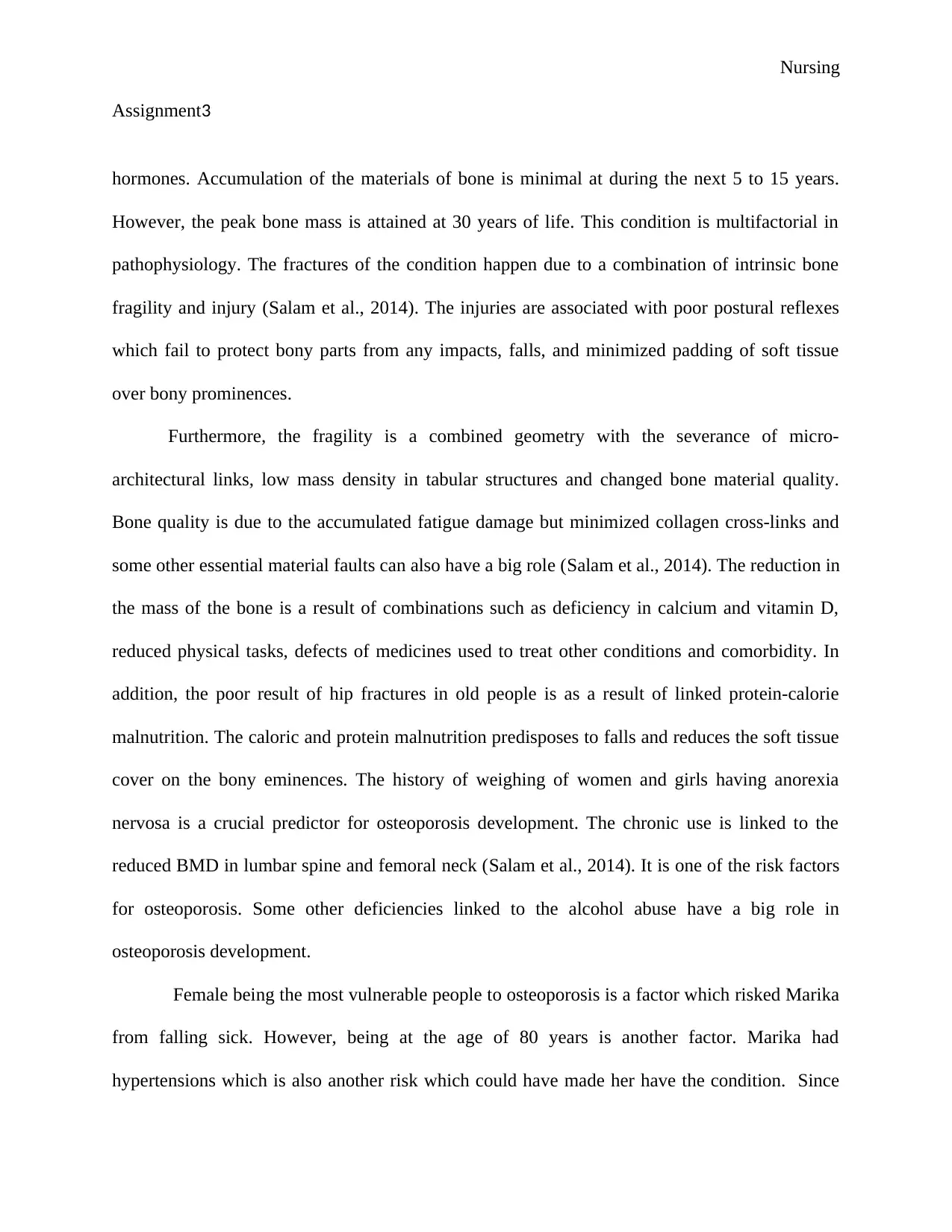
Nursing
Assignment3
hormones. Accumulation of the materials of bone is minimal at during the next 5 to 15 years.
However, the peak bone mass is attained at 30 years of life. This condition is multifactorial in
pathophysiology. The fractures of the condition happen due to a combination of intrinsic bone
fragility and injury (Salam et al., 2014). The injuries are associated with poor postural reflexes
which fail to protect bony parts from any impacts, falls, and minimized padding of soft tissue
over bony prominences.
Furthermore, the fragility is a combined geometry with the severance of micro-
architectural links, low mass density in tabular structures and changed bone material quality.
Bone quality is due to the accumulated fatigue damage but minimized collagen cross-links and
some other essential material faults can also have a big role (Salam et al., 2014). The reduction in
the mass of the bone is a result of combinations such as deficiency in calcium and vitamin D,
reduced physical tasks, defects of medicines used to treat other conditions and comorbidity. In
addition, the poor result of hip fractures in old people is as a result of linked protein-calorie
malnutrition. The caloric and protein malnutrition predisposes to falls and reduces the soft tissue
cover on the bony eminences. The history of weighing of women and girls having anorexia
nervosa is a crucial predictor for osteoporosis development. The chronic use is linked to the
reduced BMD in lumbar spine and femoral neck (Salam et al., 2014). It is one of the risk factors
for osteoporosis. Some other deficiencies linked to the alcohol abuse have a big role in
osteoporosis development.
Female being the most vulnerable people to osteoporosis is a factor which risked Marika
from falling sick. However, being at the age of 80 years is another factor. Marika had
hypertensions which is also another risk which could have made her have the condition. Since
Assignment3
hormones. Accumulation of the materials of bone is minimal at during the next 5 to 15 years.
However, the peak bone mass is attained at 30 years of life. This condition is multifactorial in
pathophysiology. The fractures of the condition happen due to a combination of intrinsic bone
fragility and injury (Salam et al., 2014). The injuries are associated with poor postural reflexes
which fail to protect bony parts from any impacts, falls, and minimized padding of soft tissue
over bony prominences.
Furthermore, the fragility is a combined geometry with the severance of micro-
architectural links, low mass density in tabular structures and changed bone material quality.
Bone quality is due to the accumulated fatigue damage but minimized collagen cross-links and
some other essential material faults can also have a big role (Salam et al., 2014). The reduction in
the mass of the bone is a result of combinations such as deficiency in calcium and vitamin D,
reduced physical tasks, defects of medicines used to treat other conditions and comorbidity. In
addition, the poor result of hip fractures in old people is as a result of linked protein-calorie
malnutrition. The caloric and protein malnutrition predisposes to falls and reduces the soft tissue
cover on the bony eminences. The history of weighing of women and girls having anorexia
nervosa is a crucial predictor for osteoporosis development. The chronic use is linked to the
reduced BMD in lumbar spine and femoral neck (Salam et al., 2014). It is one of the risk factors
for osteoporosis. Some other deficiencies linked to the alcohol abuse have a big role in
osteoporosis development.
Female being the most vulnerable people to osteoporosis is a factor which risked Marika
from falling sick. However, being at the age of 80 years is another factor. Marika had
hypertensions which is also another risk which could have made her have the condition. Since
⊘ This is a preview!⊘
Do you want full access?
Subscribe today to unlock all pages.

Trusted by 1+ million students worldwide
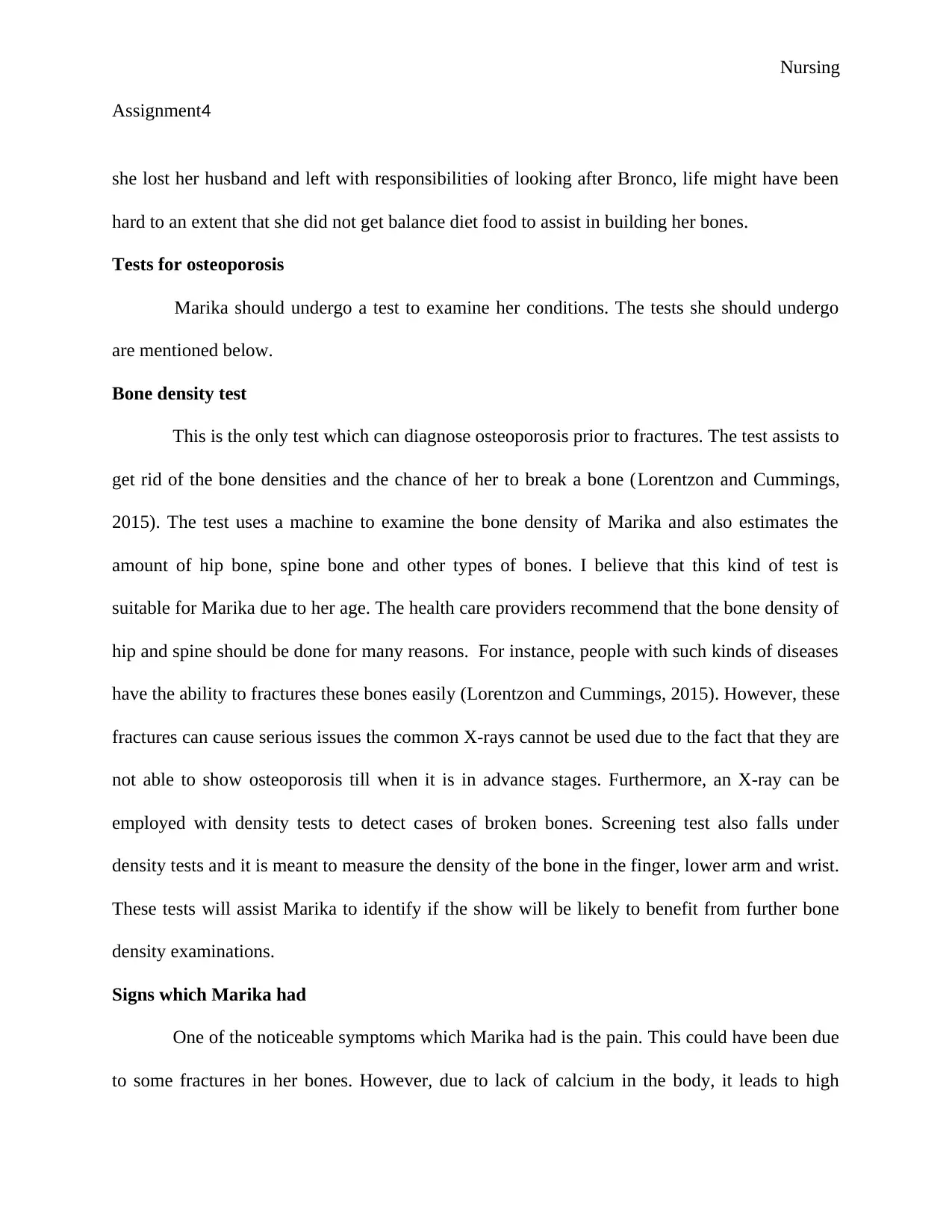
Nursing
Assignment4
she lost her husband and left with responsibilities of looking after Bronco, life might have been
hard to an extent that she did not get balance diet food to assist in building her bones.
Tests for osteoporosis
Marika should undergo a test to examine her conditions. The tests she should undergo
are mentioned below.
Bone density test
This is the only test which can diagnose osteoporosis prior to fractures. The test assists to
get rid of the bone densities and the chance of her to break a bone (Lorentzon and Cummings,
2015). The test uses a machine to examine the bone density of Marika and also estimates the
amount of hip bone, spine bone and other types of bones. I believe that this kind of test is
suitable for Marika due to her age. The health care providers recommend that the bone density of
hip and spine should be done for many reasons. For instance, people with such kinds of diseases
have the ability to fractures these bones easily (Lorentzon and Cummings, 2015). However, these
fractures can cause serious issues the common X-rays cannot be used due to the fact that they are
not able to show osteoporosis till when it is in advance stages. Furthermore, an X-ray can be
employed with density tests to detect cases of broken bones. Screening test also falls under
density tests and it is meant to measure the density of the bone in the finger, lower arm and wrist.
These tests will assist Marika to identify if the show will be likely to benefit from further bone
density examinations.
Signs which Marika had
One of the noticeable symptoms which Marika had is the pain. This could have been due
to some fractures in her bones. However, due to lack of calcium in the body, it leads to high
Assignment4
she lost her husband and left with responsibilities of looking after Bronco, life might have been
hard to an extent that she did not get balance diet food to assist in building her bones.
Tests for osteoporosis
Marika should undergo a test to examine her conditions. The tests she should undergo
are mentioned below.
Bone density test
This is the only test which can diagnose osteoporosis prior to fractures. The test assists to
get rid of the bone densities and the chance of her to break a bone (Lorentzon and Cummings,
2015). The test uses a machine to examine the bone density of Marika and also estimates the
amount of hip bone, spine bone and other types of bones. I believe that this kind of test is
suitable for Marika due to her age. The health care providers recommend that the bone density of
hip and spine should be done for many reasons. For instance, people with such kinds of diseases
have the ability to fractures these bones easily (Lorentzon and Cummings, 2015). However, these
fractures can cause serious issues the common X-rays cannot be used due to the fact that they are
not able to show osteoporosis till when it is in advance stages. Furthermore, an X-ray can be
employed with density tests to detect cases of broken bones. Screening test also falls under
density tests and it is meant to measure the density of the bone in the finger, lower arm and wrist.
These tests will assist Marika to identify if the show will be likely to benefit from further bone
density examinations.
Signs which Marika had
One of the noticeable symptoms which Marika had is the pain. This could have been due
to some fractures in her bones. However, due to lack of calcium in the body, it leads to high
Paraphrase This Document
Need a fresh take? Get an instant paraphrase of this document with our AI Paraphraser
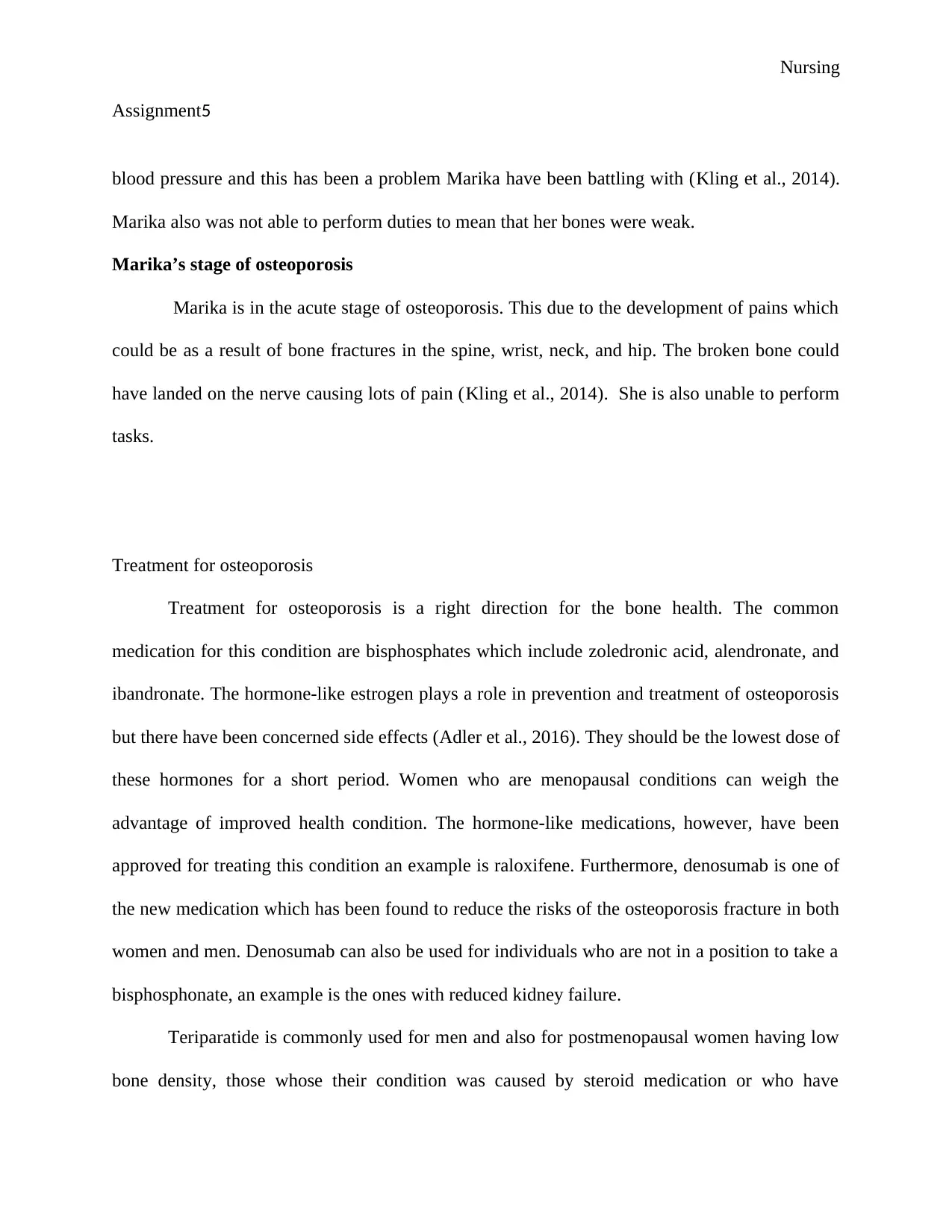
Nursing
Assignment5
blood pressure and this has been a problem Marika have been battling with (Kling et al., 2014).
Marika also was not able to perform duties to mean that her bones were weak.
Marika’s stage of osteoporosis
Marika is in the acute stage of osteoporosis. This due to the development of pains which
could be as a result of bone fractures in the spine, wrist, neck, and hip. The broken bone could
have landed on the nerve causing lots of pain (Kling et al., 2014). She is also unable to perform
tasks.
Treatment for osteoporosis
Treatment for osteoporosis is a right direction for the bone health. The common
medication for this condition are bisphosphates which include zoledronic acid, alendronate, and
ibandronate. The hormone-like estrogen plays a role in prevention and treatment of osteoporosis
but there have been concerned side effects (Adler et al., 2016). They should be the lowest dose of
these hormones for a short period. Women who are menopausal conditions can weigh the
advantage of improved health condition. The hormone-like medications, however, have been
approved for treating this condition an example is raloxifene. Furthermore, denosumab is one of
the new medication which has been found to reduce the risks of the osteoporosis fracture in both
women and men. Denosumab can also be used for individuals who are not in a position to take a
bisphosphonate, an example is the ones with reduced kidney failure.
Teriparatide is commonly used for men and also for postmenopausal women having low
bone density, those whose their condition was caused by steroid medication or who have
Assignment5
blood pressure and this has been a problem Marika have been battling with (Kling et al., 2014).
Marika also was not able to perform duties to mean that her bones were weak.
Marika’s stage of osteoporosis
Marika is in the acute stage of osteoporosis. This due to the development of pains which
could be as a result of bone fractures in the spine, wrist, neck, and hip. The broken bone could
have landed on the nerve causing lots of pain (Kling et al., 2014). She is also unable to perform
tasks.
Treatment for osteoporosis
Treatment for osteoporosis is a right direction for the bone health. The common
medication for this condition are bisphosphates which include zoledronic acid, alendronate, and
ibandronate. The hormone-like estrogen plays a role in prevention and treatment of osteoporosis
but there have been concerned side effects (Adler et al., 2016). They should be the lowest dose of
these hormones for a short period. Women who are menopausal conditions can weigh the
advantage of improved health condition. The hormone-like medications, however, have been
approved for treating this condition an example is raloxifene. Furthermore, denosumab is one of
the new medication which has been found to reduce the risks of the osteoporosis fracture in both
women and men. Denosumab can also be used for individuals who are not in a position to take a
bisphosphonate, an example is the ones with reduced kidney failure.
Teriparatide is commonly used for men and also for postmenopausal women having low
bone density, those whose their condition was caused by steroid medication or who have
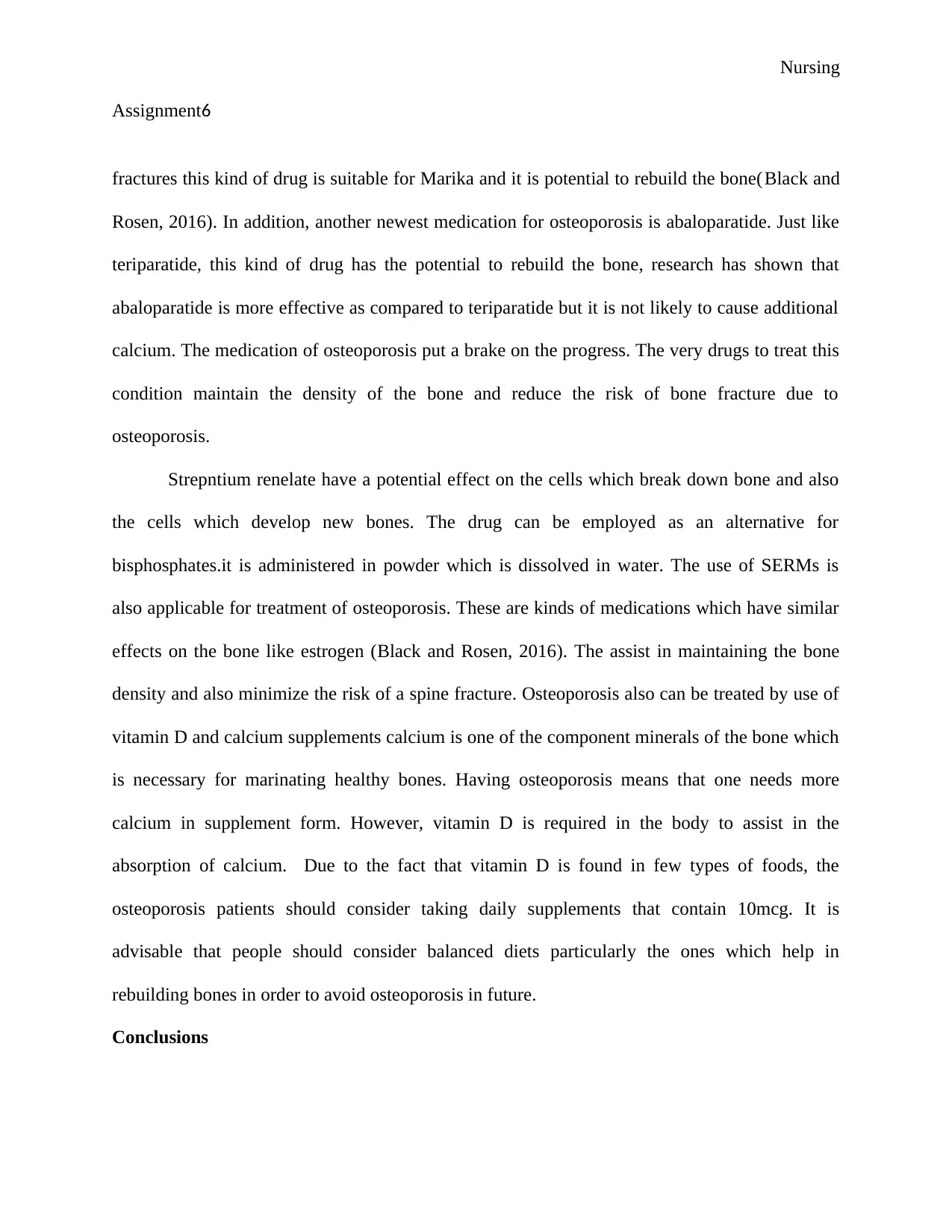
Nursing
Assignment6
fractures this kind of drug is suitable for Marika and it is potential to rebuild the bone(Black and
Rosen, 2016). In addition, another newest medication for osteoporosis is abaloparatide. Just like
teriparatide, this kind of drug has the potential to rebuild the bone, research has shown that
abaloparatide is more effective as compared to teriparatide but it is not likely to cause additional
calcium. The medication of osteoporosis put a brake on the progress. The very drugs to treat this
condition maintain the density of the bone and reduce the risk of bone fracture due to
osteoporosis.
Strepntium renelate have a potential effect on the cells which break down bone and also
the cells which develop new bones. The drug can be employed as an alternative for
bisphosphates.it is administered in powder which is dissolved in water. The use of SERMs is
also applicable for treatment of osteoporosis. These are kinds of medications which have similar
effects on the bone like estrogen (Black and Rosen, 2016). The assist in maintaining the bone
density and also minimize the risk of a spine fracture. Osteoporosis also can be treated by use of
vitamin D and calcium supplements calcium is one of the component minerals of the bone which
is necessary for marinating healthy bones. Having osteoporosis means that one needs more
calcium in supplement form. However, vitamin D is required in the body to assist in the
absorption of calcium. Due to the fact that vitamin D is found in few types of foods, the
osteoporosis patients should consider taking daily supplements that contain 10mcg. It is
advisable that people should consider balanced diets particularly the ones which help in
rebuilding bones in order to avoid osteoporosis in future.
Conclusions
Assignment6
fractures this kind of drug is suitable for Marika and it is potential to rebuild the bone(Black and
Rosen, 2016). In addition, another newest medication for osteoporosis is abaloparatide. Just like
teriparatide, this kind of drug has the potential to rebuild the bone, research has shown that
abaloparatide is more effective as compared to teriparatide but it is not likely to cause additional
calcium. The medication of osteoporosis put a brake on the progress. The very drugs to treat this
condition maintain the density of the bone and reduce the risk of bone fracture due to
osteoporosis.
Strepntium renelate have a potential effect on the cells which break down bone and also
the cells which develop new bones. The drug can be employed as an alternative for
bisphosphates.it is administered in powder which is dissolved in water. The use of SERMs is
also applicable for treatment of osteoporosis. These are kinds of medications which have similar
effects on the bone like estrogen (Black and Rosen, 2016). The assist in maintaining the bone
density and also minimize the risk of a spine fracture. Osteoporosis also can be treated by use of
vitamin D and calcium supplements calcium is one of the component minerals of the bone which
is necessary for marinating healthy bones. Having osteoporosis means that one needs more
calcium in supplement form. However, vitamin D is required in the body to assist in the
absorption of calcium. Due to the fact that vitamin D is found in few types of foods, the
osteoporosis patients should consider taking daily supplements that contain 10mcg. It is
advisable that people should consider balanced diets particularly the ones which help in
rebuilding bones in order to avoid osteoporosis in future.
Conclusions
⊘ This is a preview!⊘
Do you want full access?
Subscribe today to unlock all pages.

Trusted by 1+ million students worldwide
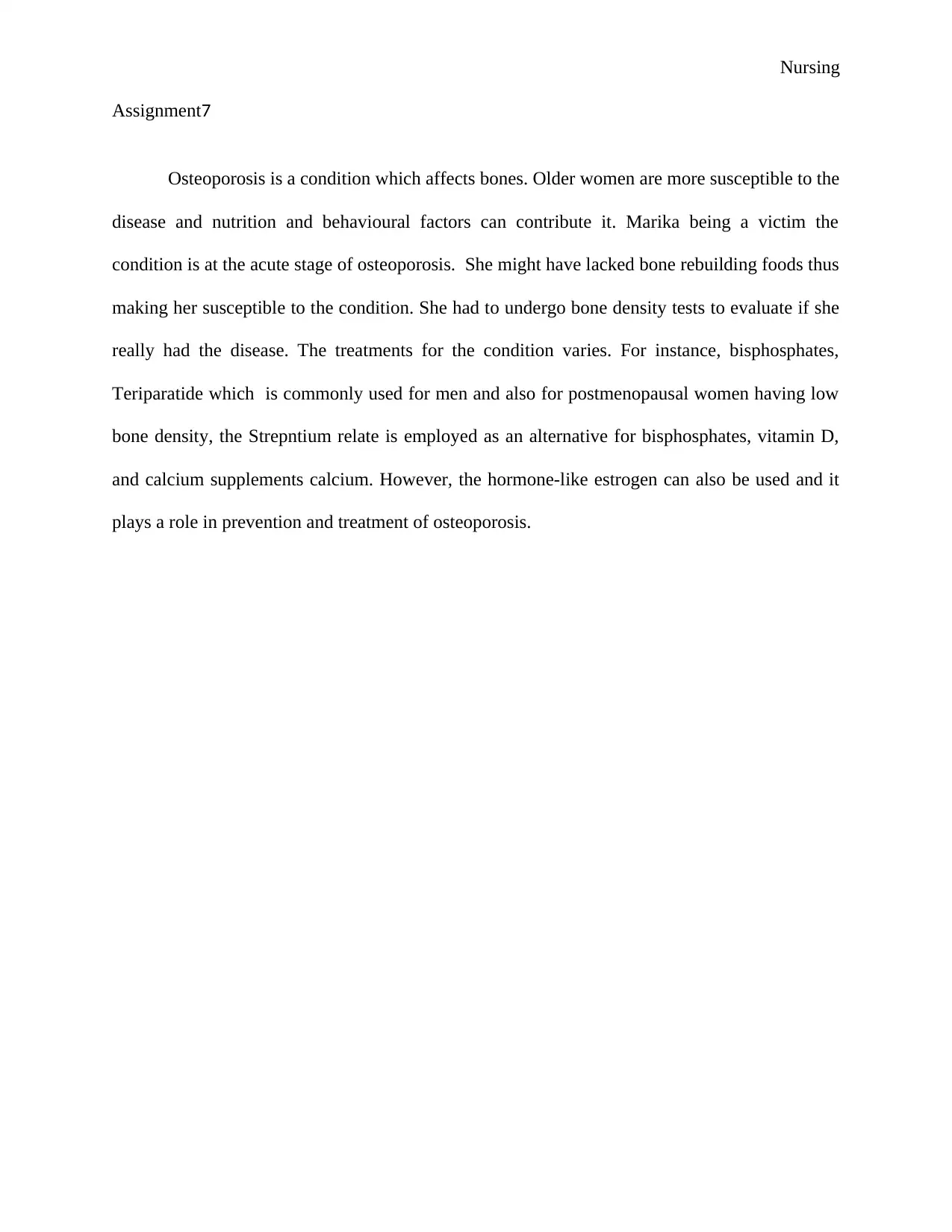
Nursing
Assignment7
Osteoporosis is a condition which affects bones. Older women are more susceptible to the
disease and nutrition and behavioural factors can contribute it. Marika being a victim the
condition is at the acute stage of osteoporosis. She might have lacked bone rebuilding foods thus
making her susceptible to the condition. She had to undergo bone density tests to evaluate if she
really had the disease. The treatments for the condition varies. For instance, bisphosphates,
Teriparatide which is commonly used for men and also for postmenopausal women having low
bone density, the Strepntium relate is employed as an alternative for bisphosphates, vitamin D,
and calcium supplements calcium. However, the hormone-like estrogen can also be used and it
plays a role in prevention and treatment of osteoporosis.
Assignment7
Osteoporosis is a condition which affects bones. Older women are more susceptible to the
disease and nutrition and behavioural factors can contribute it. Marika being a victim the
condition is at the acute stage of osteoporosis. She might have lacked bone rebuilding foods thus
making her susceptible to the condition. She had to undergo bone density tests to evaluate if she
really had the disease. The treatments for the condition varies. For instance, bisphosphates,
Teriparatide which is commonly used for men and also for postmenopausal women having low
bone density, the Strepntium relate is employed as an alternative for bisphosphates, vitamin D,
and calcium supplements calcium. However, the hormone-like estrogen can also be used and it
plays a role in prevention and treatment of osteoporosis.
Paraphrase This Document
Need a fresh take? Get an instant paraphrase of this document with our AI Paraphraser
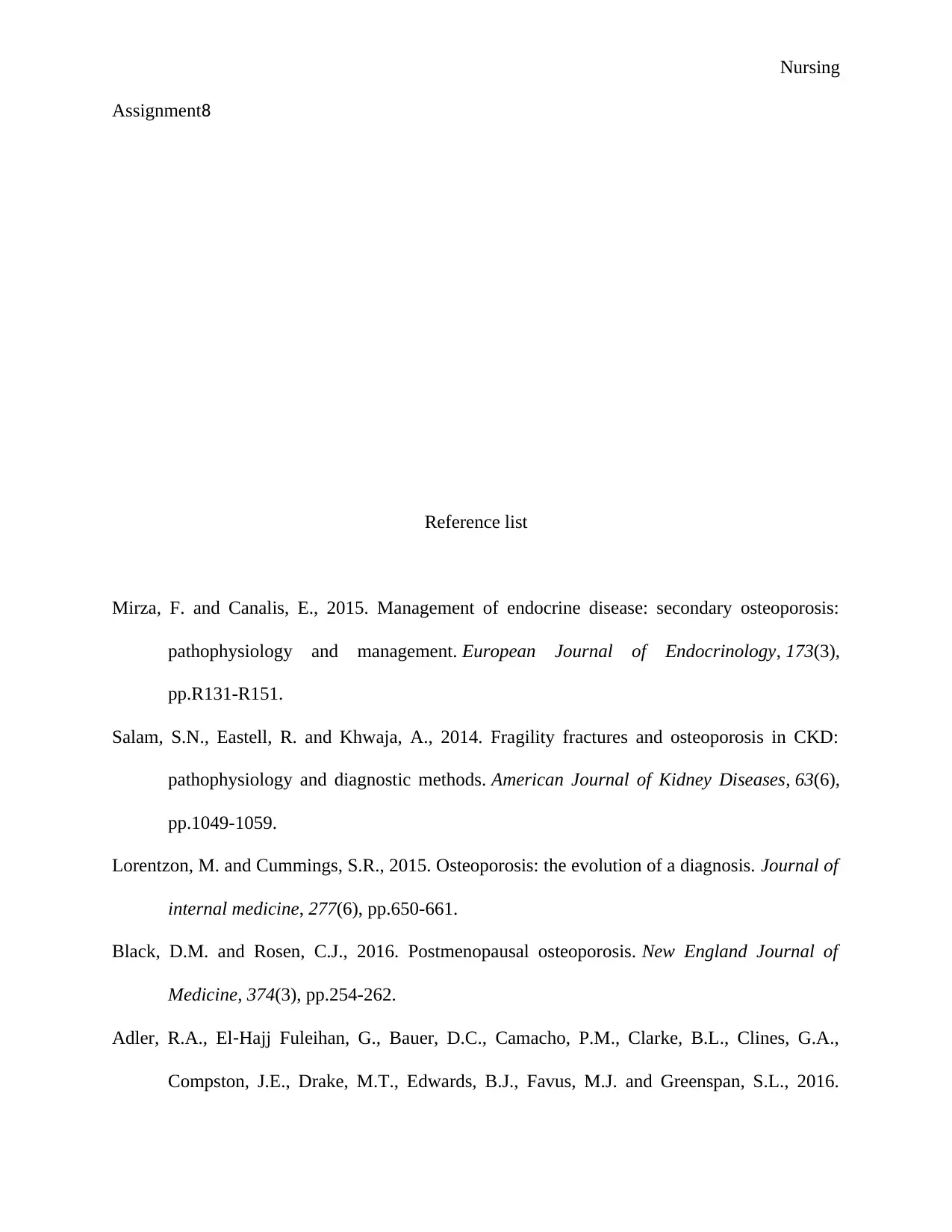
Nursing
Assignment8
Reference list
Mirza, F. and Canalis, E., 2015. Management of endocrine disease: secondary osteoporosis:
pathophysiology and management. European Journal of Endocrinology, 173(3),
pp.R131-R151.
Salam, S.N., Eastell, R. and Khwaja, A., 2014. Fragility fractures and osteoporosis in CKD:
pathophysiology and diagnostic methods. American Journal of Kidney Diseases, 63(6),
pp.1049-1059.
Lorentzon, M. and Cummings, S.R., 2015. Osteoporosis: the evolution of a diagnosis. Journal of
internal medicine, 277(6), pp.650-661.
Black, D.M. and Rosen, C.J., 2016. Postmenopausal osteoporosis. New England Journal of
Medicine, 374(3), pp.254-262.
Adler, R.A., El‐Hajj Fuleihan, G., Bauer, D.C., Camacho, P.M., Clarke, B.L., Clines, G.A.,
Compston, J.E., Drake, M.T., Edwards, B.J., Favus, M.J. and Greenspan, S.L., 2016.
Assignment8
Reference list
Mirza, F. and Canalis, E., 2015. Management of endocrine disease: secondary osteoporosis:
pathophysiology and management. European Journal of Endocrinology, 173(3),
pp.R131-R151.
Salam, S.N., Eastell, R. and Khwaja, A., 2014. Fragility fractures and osteoporosis in CKD:
pathophysiology and diagnostic methods. American Journal of Kidney Diseases, 63(6),
pp.1049-1059.
Lorentzon, M. and Cummings, S.R., 2015. Osteoporosis: the evolution of a diagnosis. Journal of
internal medicine, 277(6), pp.650-661.
Black, D.M. and Rosen, C.J., 2016. Postmenopausal osteoporosis. New England Journal of
Medicine, 374(3), pp.254-262.
Adler, R.A., El‐Hajj Fuleihan, G., Bauer, D.C., Camacho, P.M., Clarke, B.L., Clines, G.A.,
Compston, J.E., Drake, M.T., Edwards, B.J., Favus, M.J. and Greenspan, S.L., 2016.
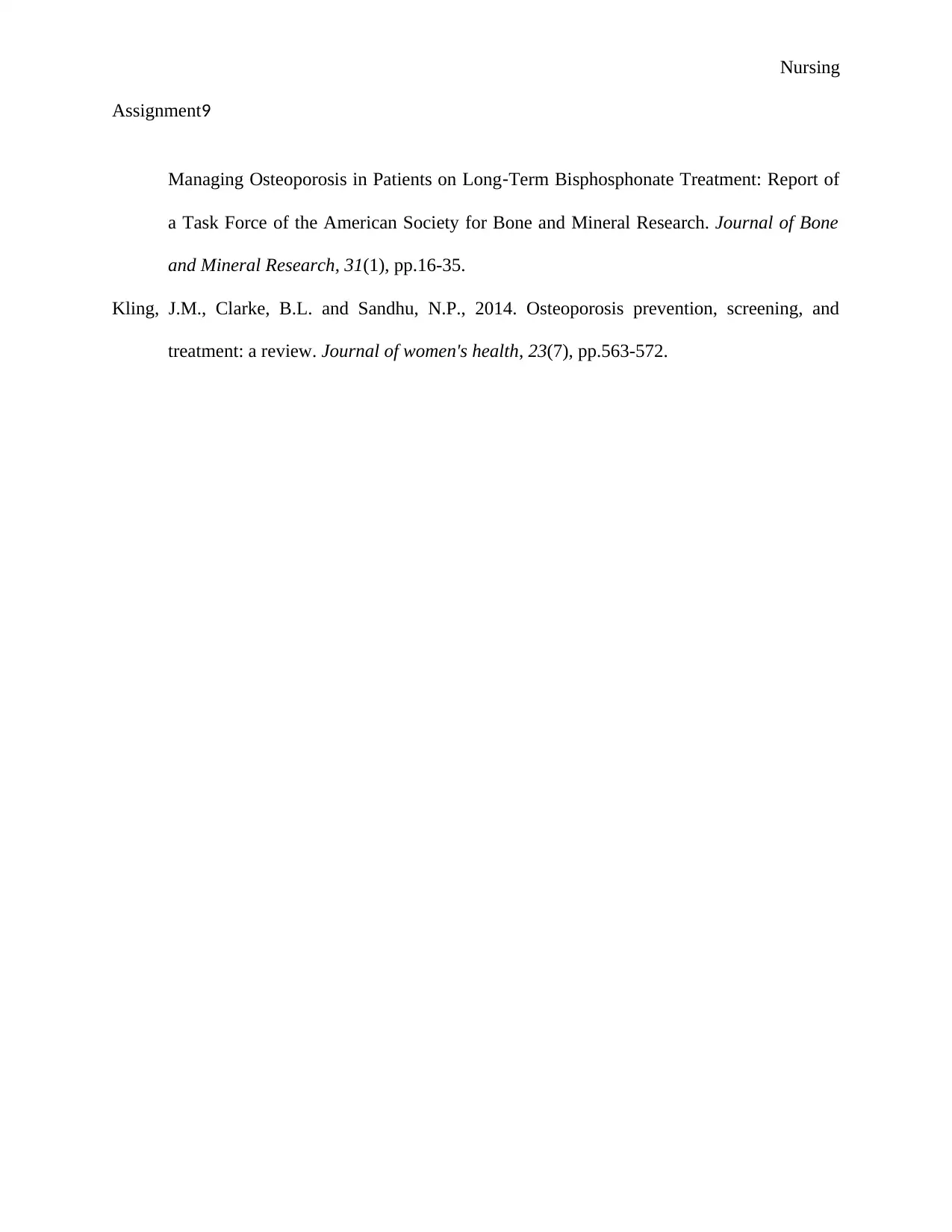
Nursing
Assignment9
Managing Osteoporosis in Patients on Long‐Term Bisphosphonate Treatment: Report of
a Task Force of the American Society for Bone and Mineral Research. Journal of Bone
and Mineral Research, 31(1), pp.16-35.
Kling, J.M., Clarke, B.L. and Sandhu, N.P., 2014. Osteoporosis prevention, screening, and
treatment: a review. Journal of women's health, 23(7), pp.563-572.
Assignment9
Managing Osteoporosis in Patients on Long‐Term Bisphosphonate Treatment: Report of
a Task Force of the American Society for Bone and Mineral Research. Journal of Bone
and Mineral Research, 31(1), pp.16-35.
Kling, J.M., Clarke, B.L. and Sandhu, N.P., 2014. Osteoporosis prevention, screening, and
treatment: a review. Journal of women's health, 23(7), pp.563-572.
⊘ This is a preview!⊘
Do you want full access?
Subscribe today to unlock all pages.

Trusted by 1+ million students worldwide
1 out of 9
Your All-in-One AI-Powered Toolkit for Academic Success.
+13062052269
info@desklib.com
Available 24*7 on WhatsApp / Email
![[object Object]](/_next/static/media/star-bottom.7253800d.svg)
Unlock your academic potential
Copyright © 2020–2025 A2Z Services. All Rights Reserved. Developed and managed by ZUCOL.
